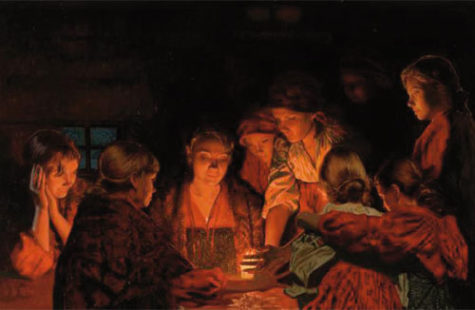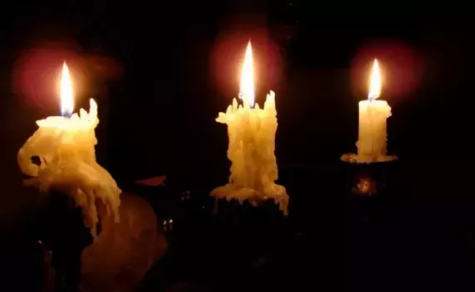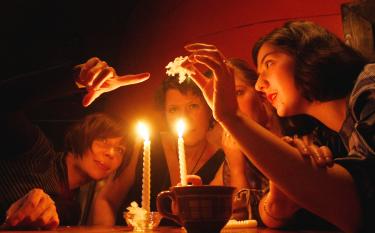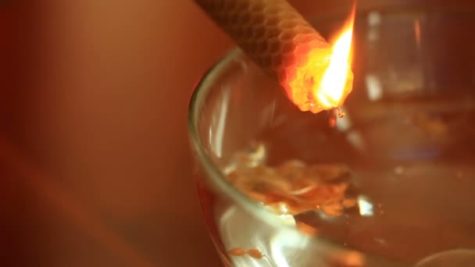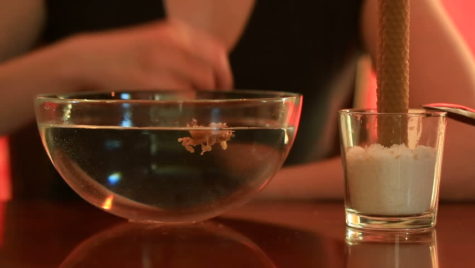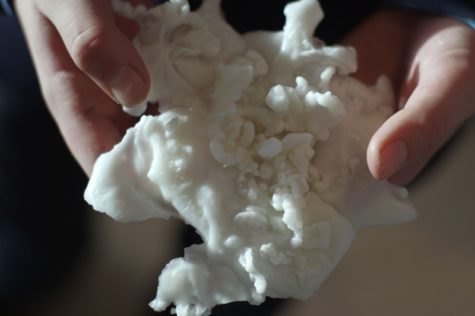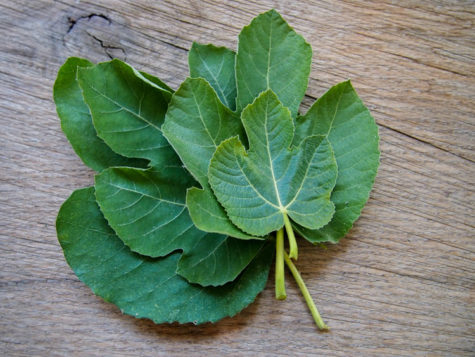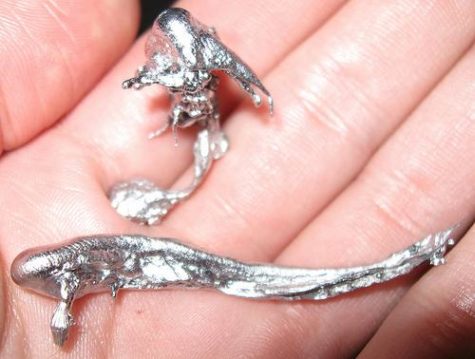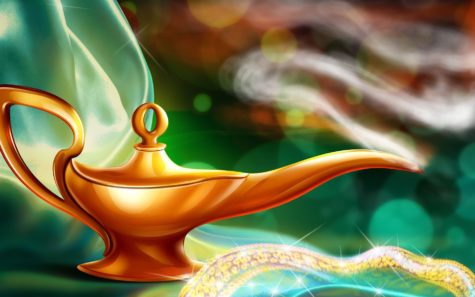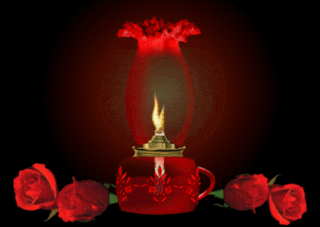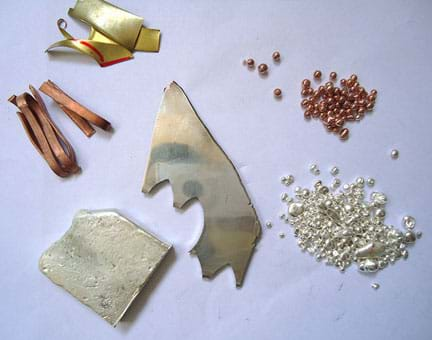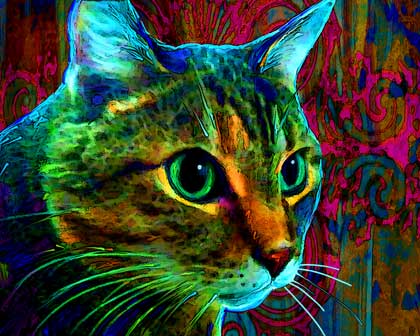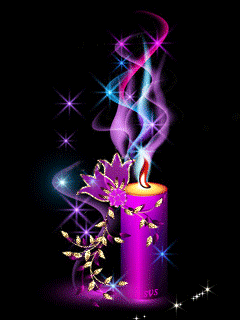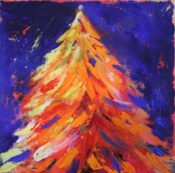Methods of Divination
Rune Casting
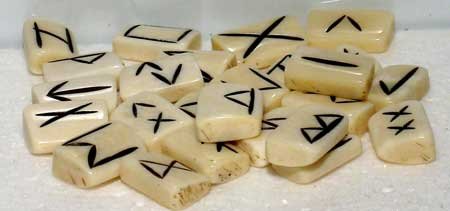
Rune Stones usually come in a set of 24 ancient alphabetic symbols, along with a book of instructions defining the symbols. They can be made of different materials – wood or glass are the most common – and usually kept in a pouch or box.
There are many versions of the Runic alphabets. Each has variations in names, shapes, esoteric meanings and magical uses. One should not mix futharks, if you do, the intent or meaning becomes confused. The Elder Futhark, the Anglo-Saxon Futhorc, and the Younger (or Scandinavian) Futhark are the most frequently seen versions of the Runic alphabets in use today.
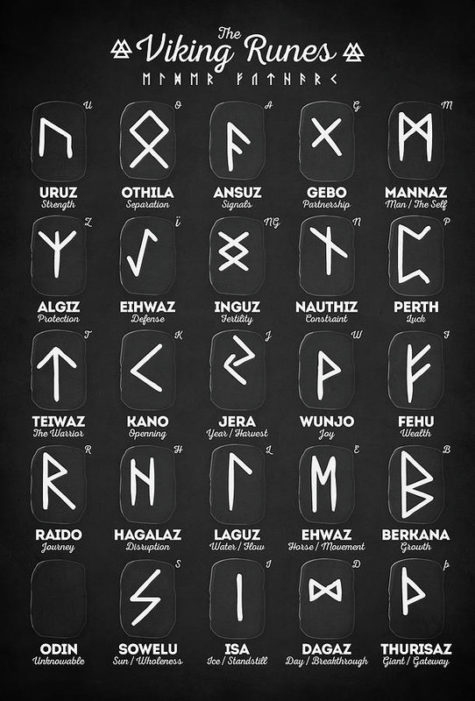
The Runes are broken into three sections or groups of eight, called aett (aettir, plural). This helps one to remember their order, and may have significance in magickal uses.
Ideally Runes are cast on an East-West axis or facing the sun. A white cloth is laid down and used to determine the direction of the casting. From here the focus should lie with the pressing question.
After casting the stones onto the cloth the ones which have fallen the right side up are read and depending upon whether the Rune is reversed or not will have a bearing on its meaning and the reading as a whole.
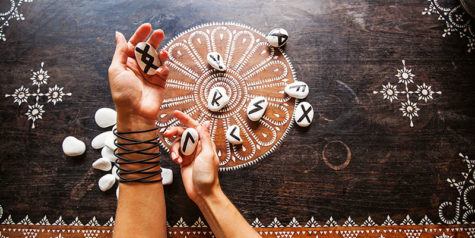
An alternative to casting the Rune stones …
Pick a Rune stone randomly for a day reading; you can also do what is known as a 3 Rune spread. Some feel that the day Rune is a good way to get an answer to a single question. The 3 Rune Spread is used for asking broader questions whereas the single Rune can be drawn on a daily basis.
- Note: The “traditional meanings of Runes should not be regarded as absolute. They are helpful indications to layers of meaning – nothing more.
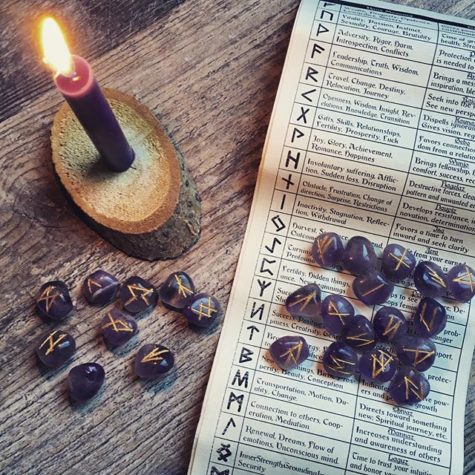
Runic divination, “runecasting”, is not “fortune telling”. Runecasting works deeply with the subconscious. The rune pouch with its runic symbols represents the entire universe. As one poses a question, one’s entire conscious and unconscious mind is focused toward that question, so that the runelots selected are not truly random selections, but rather choices made by the subconscious.
Runecraft operates on an ancient form of psychology. Even back in Viking times, there was a remarkable understanding of the human psyche. They recognized cause and effect, and the interconnectedness of all things. The word to describe this interconnectedness was “wyrd”, which was eventually perverted into the modern meaning of “weird”. It did not originally mean something unusual or strange. Rather, it referred to the far-reaching effects of that which one does.
The concept of “fate” was also not as we know it now. Instead of a helpless predestination, “fate” meant a destiny created by one’s earlier actions. Wyrd was pictured as a web, like that of a spider. The symbology is excellent. When the spider steps onto a thread (a path) the vibrations affect the entire web and that which is contained within the web, just as our actions affect our immediate world and those around us, and the actions of others affect our lives.
When one does a runic reading, one usually addresses a particular issue, and examines the past, the present and the “future”, or rather “what will be if one follows the path one appears to be on”. The future is always perceived as mutable, changeable. The runic reading is done as an evaluation process, not as fortunetelling. One has an opportunity to look at what has occurred in the past (regarding the issue being questioned), what is occurring right now, and what direction one is headed.
A runecaster does not see the future. He/she examines cause and effect and points out a likely outcome.
A short summary of the meanings and interpretations of each Rune stone can be found here. A nice tutorial on creating your own set of Rune Stones can be found at the Magickal Apothecary.
Sources:
- Rune Power
- Sunnyway
Divination By Flowers

Since ancient times, flowers have been associated with magical and Divine properties. Their appearance and the messages they can bring us make them the perfect tool for fortune telling and magical enchantment.
Flower Divination is also known as:
- Anthomancy
- Floromancy
- Floriography
One of the most popular uses for Floromancy is for love divination. In Victorian England, two flowers that had not yet blossomed would be paired, and the initials of certain lovers’ names would be placed on the stems. After placing the flowers in a secret place for 10 days, the diviner would then observe certain portents, such as, if any flower twined the other, it would indicate that the man and the woman whose initials were used were going to be married.
Another common form of Floromancy, which is very popular among young people, requires the querent to pull off the petals of flowers while making the statements such as “he/she loves” and “he/she loves me not.” The statement uttered when the last petal is pulled is supposed to be true. The “luck” attributed to finding a four-leaf clover also falls into this category.
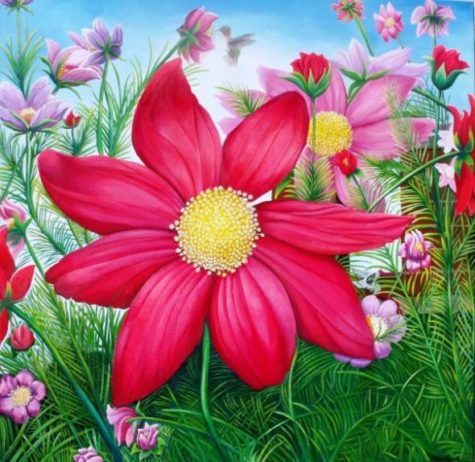
Finding the first flower of spring also has relevance in Floromancy. The type of flower and the day of the week it is found are significant for an appropriate prognostication.
- Monday, ~ means good fortune for the rest of the season.
- Tuesday ~ greatest efforts will be rewarded.
- Wednesday ~ a marriage is coming.
- Thursday ~ alertness, caution and vigilance are required throughout the season.
- Friday ~ riches and wealth are forthcoming.
- Saturday ~ misfortune is around the corner.
- Sunday ~ a sign of exceptional luck for the duration of the spring.
If the flower is a wild flower, someone with the same initial as the flower found will be attracted to you.
For example: If you find a daisy, it means someone whose name starts with a D will be attracted to you, if the flower is a Lily, someone whose name starts with a L will find you attractive.
To attract love into your life, a thorn from a white rose bush is very helpful, but only if you use it to scratch the words ‘All my love come to me’ three times on a white candle and then light it.
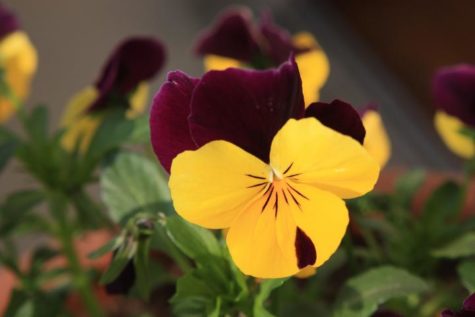
Take a question to your garden and randomly pick a petal off a pansy, without looking at it. When you examine your petal, the following information may be divined…
- If the petal has four lines in it, it is a sign of hope.
- Five lines coming from the center branch is hope founded in fear.
- Thick lines bent to the right means prosperity.
- Thick lines bent to the left mean trouble ahead.
- Seven streaks is consistent love.
- Eight streaks means fickleness in either you or those around you.
- Nine, a changing heart.
Ancient Anglo-Saxon folklore says that if you offered an expectant mother the choice between a rose and a lily, the outcome would be as follows:
- If she chose a rose, the baby would be a girl.
- If she chose the lily, the baby would be a boy.
On the other hand, the Victorians believed that if the pregnant woman went into the garden, closed her eyes, and spun around to pick a flower, the hue of the flower would tell her the sex of the baby. If it was a dark color, it was a boy, and a light color indicated a girl.
In Korea, carnations were used by girls to tell their future. A girl would place a cluster of three blossoms in her hair. If the top one died first, the girl’s last years would be difficult. If the middle one died first, her earlier years would be hard. And if the bottom one died first her entire life would be miserable.
In the East, a young woman would place a poppy petal in her lover’s hand to see if he had been true to her. Hitting the petal with the side of her hand, she listened for the sound it would make. Silence indicated he had been unfaithful.
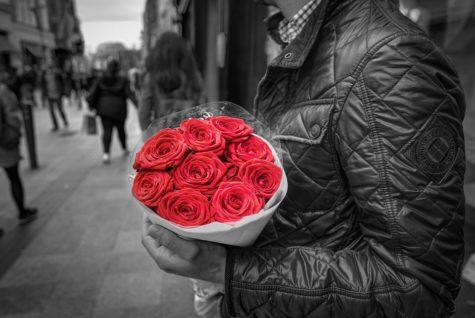
Sending Flowers
Note: the magickal meanings and uses for specific flowers might be quite different from the meanings of flowers sent to a lover or friend.
Modern flower folklore gives meaning to the flowers you send to your chosen one on Valentine’s day.
- Anemones ~ mean your love is coming to an end.
- Forget-me-nots ~ a sign of true love and constancy.
- Snowdrops ~ hope for love.
- Sunflowers ~ warm feelings.
- Red Tulips ~ a declaration of powerful love.
- Red Roses ~ a sign of passion.
- Yellow Roses ~ friendship.
- Pink Roses ~ appreciation and admiration.
If you are interested in the meanings of various flowers, you might want to explore the Language of Flowers. Here is a link to help you get started with that: Dictionary of the Language of Flowers.
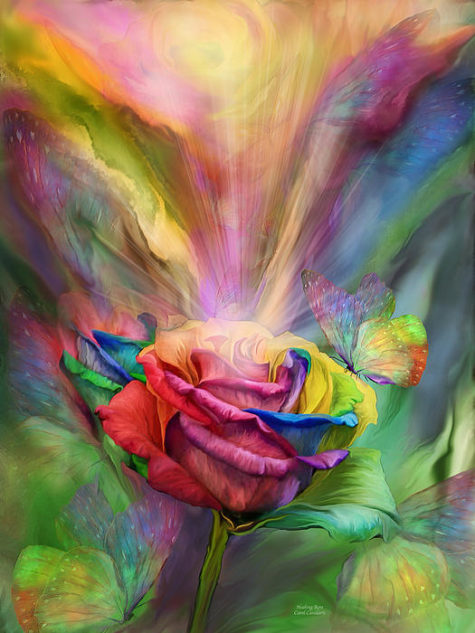
Flower Symbolism in Dreams
The appearance of certain flowers in a dream was considered an omen of things to come.
- To dream of white flowers foretells death.
- Dreams of jasmine and lilies are good omens.
- Misfortune comes when you dream of dandelions or withered roses
- Dreams of marigolds denote riches.
- Roses, of course, indicate success in love.
- If you dream of being picked by briars, it means you have an ardent desire, and the young in love often dream of being pricked by a thorn while trying to pick a rose.
- Dreaming of flowers out of season is bad luck.
- Dreams of plants currently blooming are good luck.
- Yellow flowers can mean love mixed with jealousy or that you will have more children to maintain than what justly belong to you.
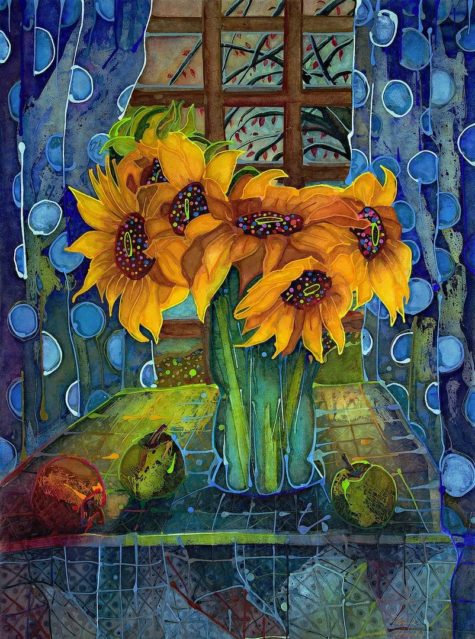
Your Lucky Flower
It is also believed that wearing the blossom associated with your month of birth would bring exceptionally good luck.
- January – snowdrop, or carnation
- February – violet, or primrose
- March – daffodil, or jonquil
- April – primrose, daisy, or sweet pea
- May – white lily, lily of the valley, or hawthorn
- June – wild rose, rose, or honeysuckle
- July – carnation, larkspur, or waterlily.
- August – white heather, gladiolus, or poppy
- September – Michaelmas daisy, aster, or morning glory
- October – rosemary, calendula, or cosmos
- November – chrysanthemum
- December – ivy, narcissus, or holly
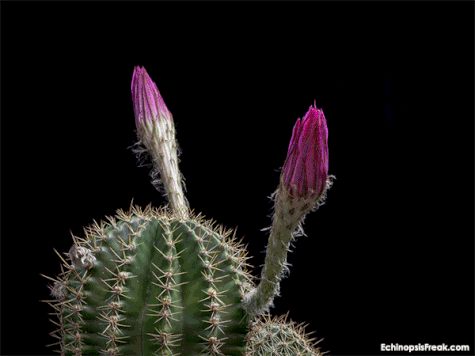
Flower psychometry
Did you know that flowers could speak? They may not have a voice-box, but they can bring you messages just the same. You probably already have a favorite type of flower. What flower would you buy for yourself if money were no object? Flowers have a type of personality don’t they? Daisies are full of innocence, white orchids are exotic and sensual, bright yellow tulips are just fun.
Make a list of all of your favorite flowers. What are they telling you just by looking at them? Are they who you are, or who you want to be?
Next select a flower. Hold it in your hands and close your eyes. Merge your soul with the energy of the flower and write down what you feel. Spend a few minutes just relaxing and holding the flower; touch it, stroke it, sense it. When you are ready, make a few notes. What is the flower telling you?
There are no right or wrong answers, it’s just a learning experience. Practice until you feel comfortable with the experience. Have a go with friends and then compare notes afterwards. Maybe you could read for each other.
Sources:
Reading Candle Wax
The art of reading a candle’s melted and hardened wax is called Carromancy. Carromancy is one of the most ancient types of divination. Wax drippings provide hints into how effectively your magic is working and if your messages are being blocked or thwarted. Divination by dripping hot wax in water is called Ceromancy or Ceroscopy.
How to Read the Signs of Carromancy
The way that a candle deconstructs as it melts can be extremely significant. Uncovering the hidden meanings of your candles wax can be done in two ways. The first is to examine and interpret the natural forms left after your candle has burned. The way the wax pools when the candle burns down, the way it drips on the sides of the candle, or if the wax “drowns” the wick all have meaning.
During the burning process, the wax melts and forms images. Transient images are the forms that the wax takes as it is melting. These images can appear as droplets or “tears.” If the tears melt and disappear by the time the candle is finished burning, it is believed that any sorrow you carry will pass quickly. If the tears harden and remain on the sides of the candle, you may be burdened with your sorrows for a long time to come before you achieve your desired goal.
The shapes taken on by the solidifying wax are called persistent images. After a candle burns, the puddle that is left should be observed for any significance to the spell it was used with. For example, if you have conducted a love-drawing spell, a heart-shaped wax puddle is a good sign. If you are burning a candle as part of a money-drawing ritual and the wax spills over onto your altar and dries on your monetary offering, the spell is working and the money has been blessed.
If you are conducting a marriage spell and incorporating a Marriage Candle into the ritual, observe which figure – the bride or groom – burns more quickly. It can be said that this partner is the more eager of the two to get married and may dominate the other after the marriage ceremony has been performed.
Novena or glass candles are often used in Hoodoo spellwork. When you are burning an encased candle, the waxy residue left behind can offer you clues. If there is a lot of wax remaining at the bottom of the glass after the candle has burned, there may be some unfinished business left for you to explore and address. A second ritual may need to be conducted to fully resolve any lingering issues. Wax left on the sides of the glass could mean that you are subconsciously blocking yourself from achieving your desires.
Look for any black soot left behind after your glass candle has burned. If the soot is mainly at the top half of your candle, the obstacle you were trying to overcome has been unblocked. Soot appearing the entire length of the candle or at the bottom of the candle should be taken as a warning that there is negative energy that is blocking your path. You may want to consider performing an uncrossing ritual to counter the negativity.
Any white soot left on the glass is a positive message from the spirits. It is a method of spiritual communication letting you know that your request has been received and your prayers have been heard.
Wax on Water: Candle Drip Divination
Another way to observe and identify the messages from the candle’s wax is by tipping the candle over a shallow bowl of water and letting some of the wax pour into the water. This is the form of divination called Ceromancy. When you drip candle wax in water, it hardens and forms images. These images can be decoded and clarified, similar to the art of reading tea leaves.
A candle wax reading is similar to reading tea leaves, but instead of reading symbols and messages formed by wet tea leaves inside your teacup, it’s the candle drippings formed in water that we interpret. No matter what type of divination tools you use, two basic elements are required:
- A Question
- An Answer.
What You Need
- Scrying Bowl – You can use just about any type of container in place of a scrying bowl. It is best to use a cup, bowl, or shallow dish made from natural materials. Ceramic or glass are good choices. You can also use an abalone shell if you like. Avoid using plastics or aluminum containers.
- Water – You can use tap water or fresh water. If the water is drinkable, then it should be just fine for your candle wax reading.
- Candle /w matches – A plain white candle is fine, or you can use a color that corresponds to your question, for example, green represents success and abundance.
- Pencil and Paper – It is important to write your question down, this will help you to decipher the answers you might be given.
- Anointing Oil – This is optional, and the oil used would depend on the type of question asked.
Performing the Divination:
Sit with your thoughts. Meditating for a few minutes before you begin will set the mood for quiet reflection. Write your question down on a piece of paper or notepad.
Fill your scrying dish with clear water. The water should be cool or room temperature. Sit at a table with the dish sitting in front of you. Alternately, you can place the dish on the floor if you wish to sit in the lotus position during your reading.
If you are using an anointing oil, start by dressing your candle. You can also magically charge your bowl of water with three drops of the same oil with which you anointed the candle.
Light the candle wick. Hold the candle upright over the water for a moment, focusing on your question. Allow a good amount of wax to pool around the wick. When the flame is fully burning and the wax has begun dripping, tilt the candle about an inch away from the water’s surface. Holding the candle over the dish allow the candle wax to drip into the water. Pour the molten wax flow from the lit candle while you ask the question.
Find your patience and let the candle get a nice pool of wax rather than a few drips. Don’t move the bowl or touch the water. Let the wax and water blend naturally.
Allow the wax to drip onto the water. The tiny drops should merge together into shapes. If they do not, you must focus harder on your question. Wax will move in the water and will continue to float around during the reading, giving you an interesting interaction between drips of wax. After a minute or two, a definitive shape will appear on the water. As it hardens, snuff out your candle. Look at the shape. Study it to see what it looks like and touch it to see if you receive any messages from the wax.
Sit quietly while you peer into the water to review the candle wax drippings. Take care to look at the shapes and the fluid movement of the floating wax particles. Individual clumps of wax may look like an animals, objects, or numbers. Also, look at the drippings as a whole to see if they are forming a complete picture. It may appear like a piece of abstract artwork that speaks to you. Allow your intuitive self to form impressions about the various wax formations. Thoughts and impressions can be fleeting so consider writing them down as they come to you for future scrutiny.
It’s kind of like staring up at the clouds, using your imagination to “see” things in the clouds … like a dragon, a house, a dog… etc. You will get your answer if you really look and put these shapes together.
If you use a clear bowl for your wax divination, you can place an astrological chart at the bottom of the bowl to give you a quick reference as to what house or part of the querent’s life the symbol floats. The closer to the center, the further away the issue is (or in the past); the closer to the edge of the bowl, the closer it is to arriving.
Numbers can indicate days, weeks, months or even years. Letters can represent clues to a person’s name or place. A circle could indicate the end of a cycle, such as a completed project. A cluster of dots might indicate a group of people. If there is one formation sitting a distance from the rest of the drippings it could represent isolation or going off on a distant trip. There are no right or wrong ways to interpret the candle wax… have some fun with it!
Once you read the wax in the bowl and it is fully cooled, pick it up. The bottom of the wax dripping will hold even more symbols and interesting messages. Wax reading is very three-dimensional!
Sometimes you will receive a little “surprise” in the wax. A special symbol that has great meaning for you. This is a gift that will bring amazing luck and miracles to you. If you see one, carefully break the shape off the glob of wax and place it under your pillow for 7 days. You’ll be amazed at what happens.
An Alternative Method:
An alternative method is to melt the candle completely and pour it into a bowl of ice water. The candle can be melted using a microwave oven, a conventional oven, or on the stove top using a double boiler. Be very careful when using any of those methods because candle wax is extremely flammable.
The candle can also be floated on top of the water, and then allowed to melt completely down. As the wax melts, it will pool on the water and create shapes. This method is best used with smaller votive candles that will melt fairly easily.
The most popular form of divination in Poland is pouring hot wax onto cold water. The wax is first melted over fire in a small mug, and then poured through a keyhole. People wait until it hardens properly in the cold water, then the pieces of wax are held against a candle to produce shadow on a wall. Its shapes symbolize things that will happen in the upcoming year.
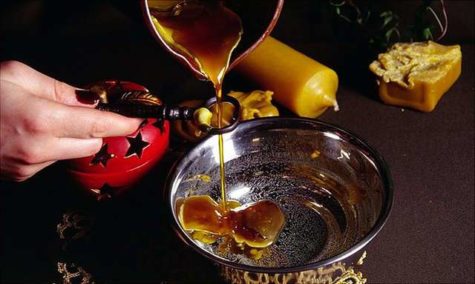
Instead of a key, in the old days people used woven straw or a horseshoe. Those who find it impossible to get a proper key sometimes cut a shape of a key out of hard cardboard.
You can also melt crayon wax and use that instead. Put the pieces of crayon in a spoon, and hold the spoon over a candle flame until it melts. Then pour the melted wax into the bowl.
Interpretation:
Do your best to be confident in your findings. Try not to dismiss them as implausible or ridiculous. Remember that images can mean different things to different people. A star may be a happy image representing freedom and faith, or it can be a sad image representing loss. What you see in your wax drippings is a very personal thing and should not be influenced by anyone but you.
Tips:
- Choose a candle color that contrasts with the color of your scrying bowl to better see the wax formations.
- The more you practice the better you will become at intuiting the answers to your questions.
- Candle waxing can be used as a sun and moon ritual. Set the water-filled dish outdoors under the moonlight overnight to soak up lunar energies. At sunrise or early morning do your reading outdoors in the sunlight.
There are many resources, including online sources and books, that can help provide meaning into the images that you see during your candle reading. It is important to remember that the most important interpretation comes from within you. Trust in your instincts and tap into what a particular image means most to you. Start with your own intuition and experience before looking up a symbol.
A Sampling of Symbols and What They Might Mean:
- Airplane – A trip of a disappointment
- Anchor – Your loved one is true
- Arrow: direction, focus
- Baby – Troubles are coming
- Ball or Balloon – Your problem will not last very long
- Beans – Money difficulties
- Bed – A vacation would be good for you
- Bells – A wedding
- Bird: vision, clarity, news will reach you soon
- Book: imagination, tradition
- Boot: travel, work, industry
- Bridge – Take a chance
- Broom – Make a change
- Candle: search for truth, spiritual growth
- Cat: impetuousness, curiosity, a friend is untrue
- Chain – Go ahead with your plans
- Chair: marriage, stagnation
- Circles: great success, reconciliation
- Cloud – Something or someone threatens you
- Coins: material security
- Crown: leadership, ego
- Cross: religious quest, do not fear for you are protected
- Crown – Sickness
- Cup – Bitter quarrel with a friend
- Dog: loyalty, dependability
- Ear – Be alert for an opportunity to advance in your work
- Egg – New developments soon
- Eye: soul, introspection
- Fan – A surprise is in store for you
- Feather: flight, independence, wanderlust, the problem will be solved
- Fish – Someone will betray you
- Flame: creativity, art
- Ghost – Someone from the past is looking for you
- Grass – Good fortune is approaching
- Hand: helpmate, relationship
- Hat – A change of location is indicated
- Heart: love, emotion, partnership
- House – Better times are coming
- Key: knowledge, education, opportunity
- Kite – Your wish will come to naught
- Ladder – Take steps to change your attitude toward an old friend
- Leaf or leaves: fertility, nature, energy, things will be changing soon
- Letters: references to the names of friends or relatives
- Lion – An unpleasant situation is developing
- Moon: denial, female intuition, more money
- Mountain – Good friends are willing to help you
- Numbers: indicators of spans of time, such as months or years
- Owl: wisdom, isolation, nocturnal
- Pants – You will be tempted
- Pen – Expect a letter from a relative
- Pin – Your lover may be attracted to another
- Pipe – Peace and comfort
- Ring – Marriage may be possible in the near future
- Scissors – Separation
- Shoe – Be suspicious of a new acquaintance
- Shovel: manual labor, hidden depths
- Snake – Be on guard against an enemy
- Spider web – Pleasant happenings
- Squares: the need for caution
- Star: spirituality, popularity, happiness
- Sun: enlightenment, happiness, children, good fortune
- Table – An abundance of blessings
- Tree: family, stability, a good time for new undertakings
- Triangles: good karma
- Umbrella – Trouble is coming
- Vase: material concerns
- Walking stick – Get out of the house and visit friends
- Wheel – One who has been away will return soon
- Witch – Danger will pass you by
- Worm – Business troubles ahead if you are not careful
Sources:
Fig Leaf Divination
Figs were considered by many to be the tree of life. This ancient method of reading fig leaves to determine the future of your life is known as sycomancy.
Write your question, scheme or proposal on a fresh fig leaf. Retain the leaf and observe it. A leaf that shrivels up quickly provides a negative response, while a leaf that dries slowly, retaining a fresh, green appearance provides encouragement.
This is also an excellent way to choose between various alternative actions. If you have a number of different ideas, plans, choices, schemes, proposals or scenarios, write each one on a fig leaf — one leaf per option or choice.
Retain the leaves so that they are together under exactly the same conditions but not touching. The leaf that remains fresh, green, and youthful looking the longest represents the oracle’s choice.
If all leaves age at exactly the same place, the indication is that there is yet another, more appropriate choice that has been overlooked. Consider your options further before making a choice.
Casting The Future
Molybdomancy is a form of divination by molten metal. The idea being that the future can be divined, and answers can be obtained by studying the various shapes taken by metal when it is melted and cooled.
A simple example is as follows:
For this you need a little lead such as the sticks provided for use in soldering. Place a small piece of this in an old spoon and hold it over a hot flame until it melts. Then, thinking of the question you want answered, toss the molten lead into a metal bucket filled with water.
This produces a satisfying cloud of steam and when the lead is fished out it will have taken a strange shape in which all kinds of things can be read. If the shape provides no clear conclusion, then it can be held up in front of a candle and the shadow thrown on the wall can be further studied.
In Finland this is still carried out regularly and horse-shoe shaped ingots and special ladles can be found in market places at this time of year.
From: The Winter Solstice
Magickal Lamp Divination
Lampadomancy is the ancient art of divining via a lamp. Magick lamps may be crafted from brass or stone, however the most common traditional lamp is formed from earth, terracotta. The oracle is determined by the appearance and duration of the flame. Lampadomancy was once a very common form of divination, dating back to the days of ancient Egypt and Mesopotamia. Because candles were once rare and expensive, magick lamps were more commonly used.
Magick lamps haven’t changed much, basically consisting of a terracotta dish filled with oil, the sides proportionately high so that oil and flames are contained. A coiled linen strip resting in the oil and hanging over the edge creates a wick. Similar lamps, reproductions as well as ancient artifacts, are available through antiquarians, but this is a very simple, even child-like design, easily crafted or improvised. A quick google search will show that hand made oil lamps can be created with bottles, tea pots, and a variety other containers.
The type of oil used in the lamp varies. Although olive oil evokes associations with The Arabian Nights, Aladdin, genies in bottles and magick lamps, actually in ancient days olive was among the more expensive oils in Arabia, Mesopotamia, and Egypt. The Egyptians, who even by modern standards possessed an extensive repertoire of oils for perfumery, cooking, sacred healing and magickal purposes, apparently favored palm oil for lamps: an oil still popular in many African and African-derived spiritual traditions.
Although lampadomancy retained its popularity in India and Arabia, it fell out of favor in the West. With the arrival of kerosene lamps in America in approximately 1869, lamp magick was revitalized. The revival was strongest in Louisiana, where it still retains some popularity.
The Louisiana Magick Lamp is typically a hurricane or kerosene lamp, fueled by some blend of castor oil, olive oil and kerosene – usually two parts kerosene to one part oil. It is read in similar manner to the ancient oil lamp.
Here’s the traditional method of divination via Magick Lamp:
Charge and consecrate a magick lamp. Formulate your question. Light the wick and read the response. Gaze at the lamp, focusing on the flames, as well as any shadows cast behind the lamp.
Watch the flames; analyze the number of points of flame. Observe in what direction the flame leans, whether it’s high, low, dim bright, noisy and sputtery, or silent. This is a patient art. Does the flame burn clean or is it smokey? If the flame goes out abruptly, this is not a positive sign.
Divination with Metals and Stones
This system is based on the concept that your connection with a particular stone or metal at times during your life reflects your need for its specific energy on the direction of your path.
Ancient diviners had splendid collections of stones and metals that they had the querist (the person questing for information) choose from. Today we may make our own collections, using samples found on our journey. It is not necessary to have fabulous, expensive stones and metal samples – rough uncut forms work quite effectively.
You may have the querist select three or four in order of preference, or just one to use for a specific question. You might also have them pick one for past, one to represent present, and one for future. If you work with the stones every day, you will begin to find your own best way to utilize them.
After a stone or metal has been selected, you might ask why that one seemed attractive in regard to the issue being discussed. If you do this before you interpret, you will find it amazing how many times the querist already “knows” the property of the stone and has chosen the exact one most needed at that time. You might also advise the querist to obtain a similar stone for use as a totem.
Traditional Meanings of Stones:
- Amethyst: Rich stone of love, good fortune, and positive spiritual magick. Can indicate a new spiritual awakening.
- Coral: Strong protection against all kinds of personal misfortunes. Can indicate deep emotional turbulence.
- Diamond: Strong attraction to power, luxury, and wealth; also attracts friendships. Can indicate the strengthening of a relationship.
- Emerald: Powerful stone for one’s present inner vision and psychic abilities. Can indicate negativity being averted.
- Garnet: Stone of honesty, truth, purity, and compassionate benevolence. Can indicate overactive selflessness.
- Jade: Sacred balancing stone for overall harmony and personal power. Can indicate a need for spiritual serenity.
- Lapis Lazuli: Stone of connection to the spiritual realms, between the worlds. Can indicate strong spirit guides are present.
- Moonstone: Stone of gentle passions and faithful supportive love. Can indicate a need for greater receptivity.
- Opal: Somewhat tricky stone of mystical attunement and perceptive gifts. Can indicate superstitious beliefs.
- Ruby: Regal stone of one’s present loyalty, faith, and powerful courage. Can indicate the quest of a spiritual warrior.
- Sapphire: Powerful stone of synthesis, peace, harmony, and healing. Can indicate a need for magical studies.
- Topaz: Active stone of protection, focus, and achievement of goals. Can indicate a need for self-confidence.
- Turquoise: Soothing stone of personal peace, Nature wisdom, ideals. Can indicate scattered energies.
Traditional Meanings of Metals
- Aluminum: Ingenuity, perception, creativity, and practical materialism. Can indicate a career change.
- Copper: Self-healing abilities, inspirational gifts, friendly nature. Can indicate a need for flexibility.
- Iron: Protective nature, strong supportive tendencies, willfulness. Can indicate possessiveness and pride.
- Lead: Mystical tasks to be achieved, karmic debts to be balanced. Can indicate piety and martyrdom.
- Silver: Receptivity, emotionality, psychic gifts, projecting power. Can indicate a secretive nature.
- Tin: Friendliness, expansiveness, joyful tasks present, positive outlook. Can indicate an overactive ego.
Notes:
The same meanings and significances apply if a specific stone or metal shows up unexpectedly in your own life, or if you feel a particular draw to a stone or metal.
Other stones and metals can be added to your collection as you discover the meanings and significance they hold. A good book for study is “Love is in the Earth” by Melody.
Ailuromancy – What is it?
Ailuromancy or aeluromancy , also known as felidomancy, is a form of theriomancy. It is divination using cats’ movements or jumps to predict future events, especially the weather.
Cats have been revered as magical since the time of the ancient Egyptians. One of the most common methods of ailuromancy utilizes the movements and behaviors of a cat to predict upcoming weather patterns.
Weather forecasting With Cats:
- A cat washing itself is believed to be a forecast of rain.
- If a cat sneezes it will rain.
- If the cat turns its tail to a fire or any substituting heat source, it foretells a possible change in weather, particularly the coming of heavy rain or hard frost.
- If a cat sits with its back to the fire, it is a sure sign of frost.
- If a cat curls up with its forehead touching the ground, it indicates that storms will happen in the near future.
Other forecasts:
- To see a cat wash behind its ears is a sign that a visitor will call.
- If a fisherman’s wife keeps a black cat in her house, her man will return safely from sea.
Gloom and doom:
- If a cat leaves a house when there is illness within, and will not be coaxed back, the sick person will die.
- A sick person will die if he or she dreams of cats or sees two cats fighting.
- If a cat sneezes three times in a row, everyone in the family will come down with a cold.
Your cat may also assist in divination:
Leave a door open and think of a question that can be answered yes or no. Call your cat into the room and notice which paw it first places on the floor. If it is the right forepaw, the answer is yes; if the cat steps with the left, the answer is no.
Collected from various sources
Debbie: Reading Candle Wax
Bridget Grimes: 310112_svyatki2_500
Mari: Reading Candle Wax
Ali: Notarikon
ALI: Notarikon
